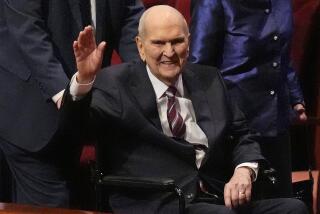PERSPECTIVE ON MORMON WOMEN : A Struggle to Reclaim Authority : The priesthood they exercised in the early church has been lost, but the voice of feminism will not be silenced.
- Share via
When Howard W. Hunter became president of the Church of Jesus Christ of Latter-day Saints last month, his first public act was a plea for alienated Mormons to “come back,” or return to fellowship. Yet more than half of the 9 million church members can never participate fully because they are women. To find reconciliation, Mormon women must look to the past.
The historical relationship of men and women in the Mormon church is a conflicted one. In 1992, I published a book that explores long-ignored aspects of that history and attempts to retrieve the soul of Mormon women’s spiritual life. For that, I was accused of apostasy.
Mormon women obtained authority early in the history of the church and then fought a losing battle to keep it. Their concerns were not taken seriously, so men’s authority prevailed. Feminism emerged in the struggle, in the energy of women’s rhetoric and work and in their resistance to male agendas.
Mormon women exercised considerable religious authority in the LDS Church for 100 years and maintained some autonomy for 140 years. During the first 20 years of Mormonism, from 1830 to 1850, women received authority for blessings, healing and prophecy; priesthood keys, powers and rituals; and missionary calls. Women clashed with male leadership and lost authority at the turn of the century and again in the 1970s. Since 1991, Mormon feminists have encountered a backlash against their attempts to reclaim women’s authority. Today’s church holds that women cannot exercise priesthood, therefore women are not “ordained” but only “set-apart” to church positions. As a full-time LDS missionary, I sensed I had priesthood, but spent 19 months being denied the right to use it.
Although women’s authority is plainly evident in Mormon history, today’s male church leaders won’t acknowledge it, for that would mean having to take responsibility for the sins of their fathers and grandfathers who revoked that authority. Instead, they blame Christ. Over and over again, male leaders assert that female priesthood is “contrary to the Lord’s plan” and that today’s church “follows the pattern the Lord has set.”
The extreme gender imbalance in Mormonism re-emerges in Utah’s masculinist culture, where government, education and business are run by Mormon men in the shadow of Salt Lake’s tallest building, the LDS church offices. In Utah, women as well as men repress the feminine, starve it and then overcompensate: We crave sweet and fatty foods for comfort; we gain weight to feel loved; men act effeminate and women self-destruct with prescription drugs, obesity, depression and too many kids. Hostility to women manifests in subtle and shocking ways. Apostle Boyd Packer said, “I could tell most of the secretaries in the church office building that they are ugly and fat. That would be the truth, but it would hurt and destroy them.”
Male-dominant culture offers women a choice between female powerlessness or male-identification. A respected local therapist told me that she sees many Mormon women who “actually believe they are men.” My book was an attempt to heal, by moving beyond male-defined identity to a place of female identification, definition and power, and by removing obstructions to women’s relationship with God.
My feminist views were never welcome in church, so I turned to the public marketplace of ideas. Yet for two years, church leaders threatened me not to speak publicly about Mormon feminist issues. Excommunication was a small price to pay for my voice. It didn’t take away my theology or my spirituality, which the church does not control. God’s spirit cannot be homogenized, mass-produced and marketed by blue-suited septuagenarians from a high-rise in downtown Salt Lake City.
I was told that my feminist ideas were “contrary to the laws and order of the church.” I agree. My excommunication was justifiable. Still, these are men’s laws and men’s orders, not women’s. In 1884, Eliza R. Snow, “prophetess” and president over all women and girls in the church, made it clear that the women’s Relief Society, which she headed, was “designed to be a self-governing organization. “If difficulties arise,” she wrote, “. . . the matter should be referred to (the) president and her counselors.” Later, when men assumed governance over women, they usurped women’s authority. I cited Snow to the 15 high priests set to judge me, but it had no impact on them. It did, however, liberate me from participating in their illusion. They excommunicated me to silence feminists and send a message of fear to Mormon women, but their action had the opposite effect: Visibility and discussion soared, and my book is in its second printing.
So, where does this leave Mormon women? They have a strong feminist tradition. Whether today’s women can reclaim their authority and priesthood in the church and fully participate remains a question; first, they must find authority within themselves. But I will not “come back” to a church that crushes female authority and individual conscience.
More to Read
Sign up for Essential California
The most important California stories and recommendations in your inbox every morning.
You may occasionally receive promotional content from the Los Angeles Times.













